Query Results for
SELECT * FROM `Item` LEFT JOIN `IndexEntry` USING (ItemID) WHERE `IsHidden` = 0 AND `Item`.`IsDeleted` = 0 AND `Language` = 'English' AND `BoardRows` = '17' ORDER BY `LinkText`, `Item`.`Summary` ASC LIMIT 500 OFFSET 0
 Dai Dai Shogi. Historical large Shogi variant. (17x17, Cells: 289) Author: H. G. Muller.
Dai Dai Shogi. Historical large Shogi variant. (17x17, Cells: 289) Author: H. G. Muller.
 Dai Dai Shogi
Dai Dai Shogi . Extremely large Shogi variant invented in the 17th century. Author: Douglas Silfen and Eduard Werner.
. Extremely large Shogi variant invented in the 17th century. Author: Douglas Silfen and Eduard Werner.
 Dai Dai Shogi Western. Missing description (17x17, Cells: 289) Author: Christine Bagley-Jones and Eduard Werner.
Dai Dai Shogi Western. Missing description (17x17, Cells: 289) Author: Christine Bagley-Jones and Eduard Werner.
 Dai-Dai Shogi pictures. Photos of a commercial Dai-dai Shogi set. Author: John Lawson.
Dai-Dai Shogi pictures. Photos of a commercial Dai-dai Shogi set. Author: John Lawson.
 Doubly Nested Chess. A variant hiding FIDE Chess on a Dabbaba binding. (17x17, Cells: 285) By Charles Gilman.
Doubly Nested Chess. A variant hiding FIDE Chess on a Dabbaba binding. (17x17, Cells: 285) By Charles Gilman.
 Haiku Shogi. 4-player Shogi with 5+7+5 grouping of orthogonals in both dimensions. (17x17, Cells: 289) By Charles Gilman.
Haiku Shogi. 4-player Shogi with 5+7+5 grouping of orthogonals in both dimensions. (17x17, Cells: 289) By Charles Gilman.
 https://www.omnichess.club/variant/bc6b6876-dbdc-419c-bba4-3e462. Missing description
https://www.omnichess.club/variant/bc6b6876-dbdc-419c-bba4-3e462. Missing description
 Nested Shogi. A variant hiding Shogi on its diagonals. (17x17, Cells: 177) By Charles Gilman.
Nested Shogi. A variant hiding Shogi on its diagonals. (17x17, Cells: 177) By Charles Gilman.
 Numeral Chess
Numeral Chess . Numeral Chess requires sharp eyes and promotes deep strategical calculation similar to Go (WeiQi). (17x17, Cells: 289) By Eric Truong.
. Numeral Chess requires sharp eyes and promotes deep strategical calculation similar to Go (WeiQi). (17x17, Cells: 289) By Eric Truong.
 Penta War
Penta War  . Huge game with five clans. By Joost Aan de Brugh.
. Huge game with five clans. By Joost Aan de Brugh.
 Penta War. Huge game with five clans. (17x17, Cells: 319) By Joost Aan de Brugh.
Penta War. Huge game with five clans. (17x17, Cells: 319) By Joost Aan de Brugh.
 Rutherford's 1-dimensional Shogi
Rutherford's 1-dimensional Shogi . Modern one-dimensional chess variant, based upon Shogi. Author: Larry L. Smith. Inventor: Jonathan H Rutherford.
. Modern one-dimensional chess variant, based upon Shogi. Author: Larry L. Smith. Inventor: Jonathan H Rutherford.
 Rutherford’s 1-dimensional Shogi. Modern one-dimensional chess variant, based upon Shogi. (1x17, Cells: 17) By Jonathan H Rutherford.
Rutherford’s 1-dimensional Shogi. Modern one-dimensional chess variant, based upon Shogi. (1x17, Cells: 17) By Jonathan H Rutherford.
 sFhIoDgEi. A variant nesting two different smaller variants within it. (17x17, Cells: 289) By Charles Gilman.
sFhIoDgEi. A variant nesting two different smaller variants within it. (17x17, Cells: 289) By Charles Gilman.
 Soccer Chess. Chess Variant inspired by soccer. (11x17, Cells: 189) By João Pedro Neto.
Soccer Chess. Chess Variant inspired by soccer. (11x17, Cells: 189) By João Pedro Neto.
 Stelliform 6 player Chess. Stellisch from Wellisch, Stellicorn from Revergent, and Stellgi and Hexgi. (17x17, Cells: 121) By Charles Gilman.
Stelliform 6 player Chess. Stellisch from Wellisch, Stellicorn from Revergent, and Stellgi and Hexgi. (17x17, Cells: 121) By Charles Gilman.
 Trigonal Chess. Translating chess onto triangles in a natural way. (9x17, Cells: 81) By Max Koval.
Trigonal Chess. Translating chess onto triangles in a natural way. (9x17, Cells: 81) By Max Koval.
